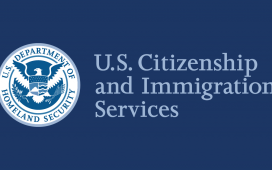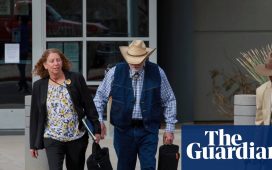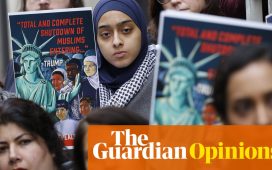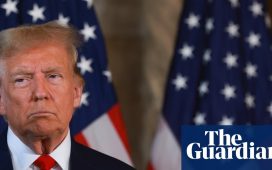The stray bullet from the gang fight struck Katery Ramos when she was 12 years old, playing on the dirt street in the poor Planeta neighbourhood of San Pedro Sula, Honduras. “I was standing up for a moment, afterwards I fell,” she told me, sitting with her mother in a scrubby field near her home.
The bullet entered just above her waist and didn’t hurt, she said. But when she arrived at the hospital, the doctor announced that it had cut through her spine. She was paralyzed from the waist down and would never walk again. Her school had no wheelchair ramps, so she left and spent her days at home lying down and watching television.
I interviewed Ramos in 2017, two years after she was shot, while researching the wider effect of gun violence in Central America. In April last year, she got ulcers linked to the paralysis, which caused blood poisoning, and she died.
Her tragedy cuts to two polarizing issues in the United States: guns and refugees. These debates are not normally connected, but the Biden administration needs to look at them together to find solutions.
An iron river of illegal guns flows from the US to Mexico, Central America, and across the hemisphere, helping make the Americas the world’s most homicidal region, with 47 of the world’s 50 most murderous cities. Thousands flee violence in the Northern Triangle of Central America – Honduras, El Salvador and Guatemala – and seek asylum in the US, adding to the pressure of undocumented migrants.
I researched gun trafficking for four years for my book Blood Gun Money: How America Arms Gangs and Cartels. In the process I traveled from the biggest firearms trade show in the world, in Las Vegas, to the open air drug markets of Baltimore, to the mass graves of Mexico. The investigation left me staggered by the scale of the trafficking and by America’s political failure to take basic measures to stop it.
Between 2007 and 2019, more than 179,000 firearms were captured in Mexico and five Central American countries and traced to gun shops and gun factories in the United States. Mexico’s foreign ministry believes this is the tip of the iceberg, and estimates that more than two million guns crossed the Rio Grande over the last decade.
The weapons originate in the legal US gun market – the biggest in the world by far, with 393 million firearms in civilian hands, according to the last count. They then cross into a parallel black market through four main methods: a private sale loophole; straw buyers (people with clean records paid to buy guns); theft from gun shops; and the sale of parts to make un-serialized weapons, or “ghost guns”.
Traffickers take these guns from states with looser laws, such as Virginia and Georgia, to cities with stricter laws, including Washington and New York, which are suffering from sharp increases in gun violence. They also smuggle them south to Mexico, over the 2,000-mile border, hidden in cars and trucks.
In Florida, smugglers stash firearms in cargo ships that sail across the Caribbean and far beyond. “You go to a shipper and you drop off a box and you say what’s in there, ‘household goods.’ They don’t care,” said Steve Barborini, a former agent for the Bureau of Alcohol, Tobacco, Firearms and Explosives, or ATF. For US guns, this is a common route to Honduras.
Various causes drive people from their homes in Central America, including extreme poverty and drought linked to climate change. But violence is a major factor, with asylum claims by Central Americans often citing attacks by gun-toting criminals.
In the town of Tenosique, Mexico, I met Honduran asylum seeker Francis Gusman, 32, who had also been shot and paralyzed by a stray bullet. Her husband and a friend took turns carrying her along a 36-mile road from the Guatemalan border. In Tijuana, I met another Honduran, David Maldonado, 31, a builder; gang members shot him in each leg for being in the wrong territory and said if they saw him again they would kill him.
In 2019 and 2020, more than 70,000 people arrived at the US’s southern border to apply for asylum, despite the Trump administration forcing them to wait in dangerous Mexican border towns, where they suffered further extortion and kidnapping. Those from Honduras were the highest number.
In February, Joe Biden ended the policy of making asylum seekers remain in Mexico. Thousands have since gone into the US to wait for their court dates. But more asylum seekers keep arriving, alongside a surge in people trying to cross illegally over the river and deserts between the border posts, putting mounting pressure on the president.
Biden has promised to reduce the root causes of immigration with a $4bn aid package for Central America. He should also act against the gun trafficking that drives the bloodshed. He could do this by supporting legislation to stop the private sale loophole, introduce federal rules on security of gun shops to reduce theft, and make it harder for criminals to acquire ghost guns; bills aimed at all of this have already been filed and Biden made a promising start of support for change with his announcement on guns on 8 April. More serious punishments for straw buyers could also have a substantial effect.
Clamping down on gun trafficking would also ameliorate violence in US cities and the relentless cartel warfare in Mexico, which refugees flee from as well. But as long as the US allows an iron river of guns to flood south, a river of refugees will keep pouring north.






